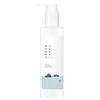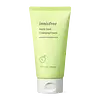What's inside
What's inside
 Key Ingredients
Key Ingredients

 Benefits
Benefits

 Concerns
Concerns

 Ingredients Side-by-side
Ingredients Side-by-side

Water
Skin ConditioningEthylhexyl Palmitate
EmollientGlycerin
HumectantDecyl Glucoside
CleansingCetyl Ethylhexanoate
EmollientDiisostearyl Malate
EmollientArachidyl Alcohol
EmollientSea Water
HumectantHyaluronic Acid
HumectantHydrolyzed Hyaluronic Acid
HumectantSodium Hyaluronate
HumectantCeramide NP
Skin ConditioningCeramide Ns
Skin ConditioningCeramide AP
Skin ConditioningCeramide As
Skin ConditioningCeramide EOP
Skin ConditioningPhytosphingosine
Skin ConditioningDipotassium Glycyrrhizate
HumectantAllantoin
Skin ConditioningPanthenol
Skin ConditioningGlyceryl Stearate
EmollientEthylhexylglycerin
Skin ConditioningGlucose
HumectantDipropylene Glycol
HumectantArachidyl Glucoside
EmulsifyingHydroxyacetophenone
AntioxidantSodium Stearoyl Glutamate
CleansingAcrylates/C10-30 Alkyl Acrylate Crosspolymer
Emulsion StabilisingCaprylyl Glycol
EmollientButylene Glycol
HumectantHydrogenated Lecithin
EmulsifyingRosmarinus Officinalis Leaf Oil
MaskingCitrus Aurantium Bergamia Fruit Oil
MaskingLavandula Hybrida Oil
EmollientJuniperus Virginiana Oil
MaskingStearic Acid
CleansingTocopherol
Antioxidant1,2-Hexanediol
Skin ConditioningXanthan Gum
EmulsifyingDisodium EDTA
Cetearyl Alcohol
EmollientBehenyl Alcohol
EmollientCholesterol
EmollientCitric Acid
BufferingWater, Ethylhexyl Palmitate, Glycerin, Decyl Glucoside, Cetyl Ethylhexanoate, Diisostearyl Malate, Arachidyl Alcohol, Sea Water, Hyaluronic Acid, Hydrolyzed Hyaluronic Acid, Sodium Hyaluronate, Ceramide NP, Ceramide Ns, Ceramide AP, Ceramide As, Ceramide EOP, Phytosphingosine, Dipotassium Glycyrrhizate, Allantoin, Panthenol, Glyceryl Stearate, Ethylhexylglycerin, Glucose, Dipropylene Glycol, Arachidyl Glucoside, Hydroxyacetophenone, Sodium Stearoyl Glutamate, Acrylates/C10-30 Alkyl Acrylate Crosspolymer, Caprylyl Glycol, Butylene Glycol, Hydrogenated Lecithin, Rosmarinus Officinalis Leaf Oil, Citrus Aurantium Bergamia Fruit Oil, Lavandula Hybrida Oil, Juniperus Virginiana Oil, Stearic Acid, Tocopherol, 1,2-Hexanediol, Xanthan Gum, Disodium EDTA, Cetearyl Alcohol, Behenyl Alcohol, Cholesterol, Citric Acid
Water
Skin ConditioningCetyl Ethylhexanoate
EmollientOctyldodecanol
EmollientIsopropyl Palmitate
EmollientHydrogenated Poly(C6-14 Olefin)
EmollientButylene Glycol
HumectantDicaprylyl Ether
EmollientDipropylene Glycol
HumectantHydrogenated Vegetable Oil
Emollient1,2-Hexanediol
Skin ConditioningGlyceryl Stearate
EmollientCetearyl Alcohol
EmollientPolysorbate 60
EmulsifyingParfum
MaskingC14-22 Alcohols
Emulsion StabilisingCarbomer
Emulsion StabilisingTromethamine
BufferingC12-20 Alkyl Glucoside
EmulsifyingGlyceryl Caprylate
EmollientDisodium EDTA
Ethylhexylglycerin
Skin ConditioningPyrus Malus Seed Oil
EmollientCoco-Caprylate/Caprate
EmollientCaprylic/Capric Triglyceride
MaskingPyrus Malus Fruit Extract
Skin ConditioningGlucose
HumectantTocopherol
AntioxidantGlycine Soja Oil
EmollientWater, Cetyl Ethylhexanoate, Octyldodecanol, Isopropyl Palmitate, Hydrogenated Poly(C6-14 Olefin), Butylene Glycol, Dicaprylyl Ether, Dipropylene Glycol, Hydrogenated Vegetable Oil, 1,2-Hexanediol, Glyceryl Stearate, Cetearyl Alcohol, Polysorbate 60, Parfum, C14-22 Alcohols, Carbomer, Tromethamine, C12-20 Alkyl Glucoside, Glyceryl Caprylate, Disodium EDTA, Ethylhexylglycerin, Pyrus Malus Seed Oil, Coco-Caprylate/Caprate, Caprylic/Capric Triglyceride, Pyrus Malus Fruit Extract, Glucose, Tocopherol, Glycine Soja Oil
 Reviews
Reviews

Ingredients Explained
These ingredients are found in both products.
Ingredients higher up in an ingredient list are typically present in a larger amount.
1,2-Hexanediol is a synthetic liquid and another multi-functional powerhouse.
It is a:
- Humectant, drawing moisture into the skin
- Emollient, helping to soften skin
- Solvent, dispersing and stabilizing formulas
- Preservative booster, enhancing the antimicrobial activity of other preservatives
Butylene Glycol (or BG) is used within cosmetic products for a few different reasons:
Overall, Butylene Glycol is a safe and well-rounded ingredient that works well with other ingredients.
Though this ingredient works well with most skin types, some people with sensitive skin may experience a reaction such as allergic rashes, closed comedones, or itchiness.
Learn more about Butylene GlycolCetearyl alcohol is a mixture of two fatty alcohols: cetyl alcohol and stearyl alcohol. It is mainly used as an emulsifier. Emulsifiers help prevent the separation of oils and products. Due to its composition, it can also be used to thicken a product or help create foam.
Cetearyl alcohol is an emollient. Emollients help soothe and hydrate the skin by trapping moisture.
Studies show Cetearyl alcohol is non-toxic and non-irritating. The FDA allows products labeled "alcohol-free" to have fatty alcohols.
This ingredient is usually derived from plant oils such as palm, vegetable, or coconut oils. There is debate on whether this ingredient will cause acne.
Due to the fatty acid base, this ingredient may not be Malassezia folliculitis safe.
Learn more about Cetearyl AlcoholCetyl Ethylhexanoate is an emollient ester. It comes from cetearyl alcohol and 2-ethylhexanoic acid.
Cetyl Ethylhexanoate is an emollient that adds a velvety feel to skin without being greasy or oily. Emollients help trap moisture into your skin, keeping your skin soft and hydrated.
Dipropylene Glycol is a synthetically created humectant, stabilizer, and solvent.
This ingredient helps:
Dipropylene glycol is technically an alcohol, but it belongs to the glycol family (often considered part of the ‘good’ alcohols). This means it is hydrating and gentle on skin unlike drying solvent alcohols like denatured alcohol.
As a masking agent, Dipropylene Glycol can be used to cover the smell of other ingredients. However, it does not have a scent.
Studies show Dipropylene Glycol is considered safe to use in skincare.
Learn more about Dipropylene GlycolDisodium EDTA plays a role in making products more stable by aiding other preservatives.
It is a chelating agent, meaning it neutralizes metal ions that may be found in a product.
Disodium EDTA is a salt of edetic acid and is found to be safe in cosmetic ingredients.
Learn more about Disodium EDTAEthylhexylglycerin (we can't pronounce this either) is commonly used as a preservative and skin softener. It is derived from glyceryl.
You might see Ethylhexylglycerin often paired with other preservatives such as phenoxyethanol. Ethylhexylglycerin has been found to increase the effectiveness of these other preservatives.
Glucose is a simple sugar and is the most important source of energy in all organisms.
In skincare, glucose is used to hydrate the skin. It also acts as a prebiotic for our natural biome.
Glucose is hydrating due to its humectant property. As a humectant, glucose draws moisture from the air and from deeper levels in the skin.
Our skin contains many sugars that act as prebiotics and help strengthen our natural microbiome. Having a healthy microbiome helps protect our skin from harmful bacteria and other contaminants.
Studies show glucose may help with fading discoloration and pigmentation. This is because our skin metabolizes glucose into lactic acid. Lactic acid is an AHA that helps exfoliate the top layer of skin.
Learn more about GlucoseGlyceryl Stearate is a mix of glycerin and stearic acid.
It is used to stabilize the mixing of water and oil ingredients. By preventing these ingredients from separating, it can help elongate shelf life. It can also help thicken the product's texture.
As an emollient, it helps soften skin and supports barrier-replenishing ingredients.
In cosmetics, Glyceryl Stearate is often made from vegetable oils or synthetically produced.
This ingredient may not be fungal-acne safe
Fun fact: The human body also creates Glyceryl Stearate naturally.
Learn more about Glyceryl StearateTocopherol (also known as Vitamin E) is a common antioxidant used to help protect the skin from free-radicals and strengthen the skin barrier. It's also fat soluble - this means our skin is great at absorbing it.
Vitamin E also helps keep your natural skin lipids healthy. Your lipid skin barrier naturally consists of lipids, ceramides, and fatty acids. Vitamin E offers extra protection for your skin’s lipid barrier, keeping your skin healthy and nourished.
Another benefit is a bit of UV protection. Vitamin E helps reduce the damage caused by UVB rays. (It should not replace your sunscreen). Combining it with Vitamin C can decrease sunburned cells and hyperpigmentation after UV exposure.
You might have noticed Vitamin E + C often paired together. This is because it is great at stabilizing Vitamin C. Using the two together helps increase the effectiveness of both ingredients.
There are often claims that Vitamin E can reduce/prevent scarring, but these claims haven't been confirmed by scientific research.
Learn more about TocopherolWater. It's the most common cosmetic ingredient of all. You'll usually see it at the top of ingredient lists, meaning that it makes up the largest part of the product.
So why is it so popular? Water most often acts as a solvent - this means that it helps dissolve other ingredients into the formulation.
You'll also recognize water as that liquid we all need to stay alive. If you see this, drink a glass of water. Stay hydrated!
Learn more about Water